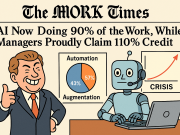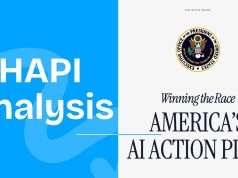The Department of Health and Human Services announced the layoff of 10,000 workers and the closure of multiple agencies amid broader efforts to streamline operations and reallocate responsibilities. While framed as an efficiency-driven reform, the move has generated significant uncertainty, concern, and resistance from staff and public health experts.
Let’s assess this restructuring through the five dimensions of HAPI:
For anyone looking to learn more about HAPI benchmark [from TAOLabs], refer to: https://noworkerleftbehind.org/hapi
1. Cognitive Adaptability
Assessment: Moderate to Low
- Organizational agility is under strain. The suddenness of the announcement, lack of advance notice, and limited transition planning suggest the organization is not demonstrating high learning agility or problem-solving foresight.
- Individual workers, especially in research and policy domains (NIH, FDA, CDC), likely have high baseline cognitive adaptability—these roles demand continual learning. However, cognitive adaptability is compromised under uncertainty, and here the abrupt change without clear reskilling pathways hinders adaptive responses.
Key Insight: The systemic failure to engage in strategic foresight (e.g., planning for how mission-critical work will be absorbed or transitioned) reveals a deficit in institutional cognitive flexibility.
2. Emotional Adaptability
Assessment: Low (Acute Stress Risk)
- Emotional reactions reported—fear, anxiety, frustration, and feeling “villainized”—indicate low emotional adaptability at the organizational level.
- HHS workers are managing disempowerment, ambiguity, and loss of mission identity without structured psychological support or transition coaching.
Risks: Without interventions (e.g., resilience training, stress debriefs), this emotional strain will undermine productivity, morale, and long-term engagement.
3. Behavioral Adaptability
Assessment: Mixed
- Staff facing abrupt organizational changes must adjust workflows and expectations. However, lack of clarity about roles, remaining responsibilities, and new leadership structures limits proactive behavior change.
- Early retirements and voluntary exits may reflect avoidance behavior—not true behavioral adaptability, but instead, withdrawal from unsupportable change.
Opportunity: Providing clear behavioral pathways (e.g., retraining, job-matching programs) could enable more productive adjustments.
4. Social Adaptability
Assessment: Severely Disrupted
- Social trust is fractured. Employees report being blindsided, fearing retaliation, and expressing isolation (“guillotine over our necks”).
- The erosion of psychological safety, combined with dismantled inter-agency collaborations, reduces team resilience and collective adaptability.
Impact: The dismantling of agencies like HRSA and SAMHSA not only disrupts internal cohesion but also decimates long-standing community-based relationships, weakening HHS’s social learning networks.
5. Growth Potential
Assessment: Undermined at Both Individual and Institutional Levels
- HAPI defines growth potential as a forward-looking measure of an individual or institution’s capacity to evolve and lead. The current restructuring appears regressive—shuttering agencies created by congressional mandate, discarding infrastructure built over decades.
- For individual workers, no clear reskilling or leadership transition plans were announced. Opportunities for professional development, cross-functional training, or mobility are unclear.
Outlook: The lack of transparent pathways to reintegrate talent or reassign strategic responsibilities implies a suppression, not elevation, of long-term potential.
Overall HAPI Adaptability Score: 44/100
- Cognitive: 10/15 – Strong legacy capability, weakened by poor communication and foresight.
- Emotional: 6/15 – Stress management systems absent or under-communicated.
- Behavioral: 8/15 – Workers lack agency in how to adapt behaviorally.
- Social: 5/15 – Breakdown in collaborative trust, cultural erosion.
- Growth Potential: 15/40 – Severely impacted by institutional contraction and absence of reskilling initiatives.
Key Strengths
- Deep existing institutional expertise (NIH, FDA).
- Employees with high scientific and technical adaptability in normal circumstances.
- Possible opportunities for reinvention if structural redesign is inclusive and data-informed.
Areas for Improvement
- Communications Strategy: Introduce transparent, bidirectional communication to rebuild trust and guide adaptability.
- Resilience & Emotional Support: Launch mental health support programs and resilience workshops for affected workers.
- Behavioral Nudges: Provide clear frameworks, milestones, and behavioral anchors to help teams transition into restructured workflows.
- Redeployment Framework: Map out a workforce transition plan that matches displaced talent with emerging public health needs (e.g., climate health, AI in diagnostics).
- Social Reconnection: Facilitate new collaboration structures (e.g., “HHS Change Ambassadors”) to rebuild inter-agency trust and accelerate adaptive teaming.
Forward Strategy Using HAPI
- Adaptive Leadership Initiative: Identify individuals with high HAPI growth potential to co-lead transformation and guide cultural change.
- Dynamic Reskilling Fund: Allocate a portion of the $1.8B projected savings to upskill laid-off or transitioning staff into adjacent high-demand areas (digital health, data science, biosecurity).
- Longitudinal HAPI Monitoring: Implement HAPI assessments at the department level to measure adaptability growth during the restructuring process and identify high-performing transition teams.





























